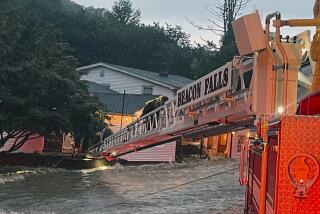Some New Yorkers defy evacuation orders even after urgent warnings
NEW YORK CITY - Stay home.
Unless you live in an evacuation area. In that case, the word from officials up and down the Northeast coast was: Go before it’s too late.
“Get out before you can’t,” Connecticut’s governor, Dannel Malloy, told residents of his state early Monday as Hurricane Sandy’s broad bands of high wind and heavy rain began hitting the region. From coastal Virginia up through Maryland, Delaware and New Jersey -- where Sandy was expected to make landfall -- through New York, Connecticut and northward, trees bent from the wind, foam-topped gray waves crashed over boardwalks and sea walls, and millions of people nervously awaited Sandy’s wrath.
PHOTOS: Hurricane Sandy approaches
New York’s harbor, bridges and major roads, normally abuzz with activity on a Monday morning, were quiet as the sun rose. Officials announced they would close two tunnels, the Holland and the Brooklyn-Battery, that link Manhattan to Brooklyn and to New Jersey, at 2 p.m, and warned they would close major bridges if winds reached 60 mph.
Whitecaps dotted the waters around the Statue of Liberty, lower Manhattan, and in the East and Hudson rivers, where all ferry service was halted. Street signs shuddered in the wind, which howled as it roared down the narrow, tunnel-like avenues of New York City.
Cafes, most shops and even McDonald’s and Starbucks outposts were closed in most of the city. “Oy Sandy! Enough already,” someone scrawled in big black graffiti on boards covering one store window.
PHOTOS: Massive U.S. storms -- Frankenstorm, Snowpocalypse and more
Many people defied the mandatory evacuation orders, opting instead to pile sandbags in front of doors, board windows with wood planks, and empty store shelves of food and water. As of 8 a.m., only 2,753 people had showed up at the 76 emergency storm shelters, mostly public schools, set up in New York City, where some 375,000 residents were in areas under evacuation orders.
New York Mayor Michael Bloomberg, in an effort to force people in low-lying, flood-prone areas to flee, said he would shut off power and hot water to 26 public housing high-rise developments in the evacuation areas. Police cars and vans patrolled with flashing lights.
Because of the full moon, the high tides on Monday night and Tuesday morning were expected to be far higher, enough perhaps to swamp densely populated areas of lower Manhattan, New Jersey, Long Island and Connecticut.
In Red Hook, Brooklyn, a mandatory evacuation area, Pat Murano was still struggling Sunday evening with whether to stay in his basement apartment or heed the evacuation order. Murano said he had not planned to go because his street was spared flooding during Tropical Storm Irene in August 2011. But as he saw others stack sandbags at doorsteps and pound wood over their windows, Murano admitted his apathy began turning to worry.
“It’s a contagious enthusiasm for taking precautions,” Murano said as his friend, Samantha Citrin, drove off to fetch filler for sandbags. “I think we’re staying,” Murano finally said as he pondered how best to nail a wooden plank over his windows.
Others also seemed to shrug off the storm. Some jogged, walked their dogs, and bought their usual coffee and bagels at neighborhood delis.
By early Monday, power outages were reported in some areas of Long Island and New Jersey, and Malloy warned residents in Connecticut -- many of whom suffered blackouts for days after Irene -- should expect long outages and dangerous storm surges in Long Island Sound.
“I’m not going to mince words. This is the most catastrophic event we have faced in any of our lifetimes,” said Malloy.
ALSO:
Get blankets, stay off roads, Virginia governor urges
Some in Atlantic City roll the dice with Hurricane Sandy
Hurricane Sandy as ‘super storm’: Is climate change a factor?
More to Read
Sign up for Essential California
The most important California stories and recommendations in your inbox every morning.
You may occasionally receive promotional content from the Los Angeles Times.











